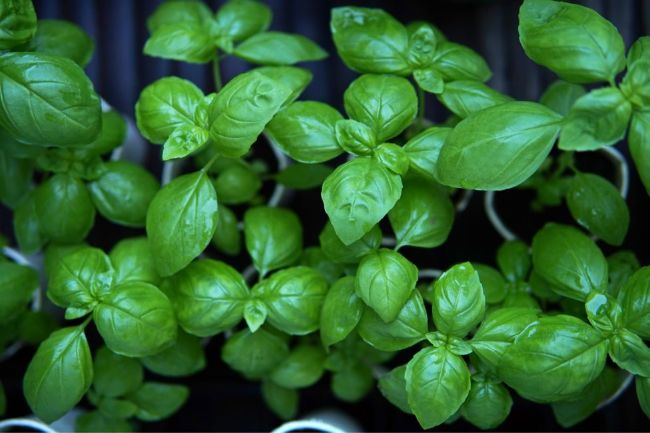Basil is just one of several herbs that you can propagate, whether you want to transplant the cuttings into the garden or grow in pots on your windowsill. When you learn how to propagate basil, you’ll be able to enjoy a constant supply of this fragrant herb all year round.
How to propagate basil. It’s simple and can be done in just a few steps. Start with just one healthy basil plant from which you can get several cuttings. You then have the option of propagating cuttings in water or in a potting medium. After two to three weeks, your cuttings will be ready for planting indoors in pots or out in your garden.
It’s really that simple. Here’s everything you need to know about propagating basil, including how to propagate in water or soil, how to plant basil from seeds, and how to safely transplant your new cuttings.
The Wonders of Basil
Basil is one of the easiest herbs to grow on your windowsill. It’s also one of the tastiest and versatile, adding flavor to a wide variety of foods. But buying fresh basil is expensive, particularly during the winter months. One way to have basil handy year-round and adorn your kitchen with greenery is to propagate the herb from cuttings. This way one plant can turn into a constant source of basil.
Propagating basil in water or soil is also much faster than growing the plant from seeds. It can take a few weeks for basil grown from seeds to be ready for use. Rooting basil from cuttings and then transplanting each “new” basil plant into the garden or into a pot lets you start enjoying this delicious herb that much sooner.
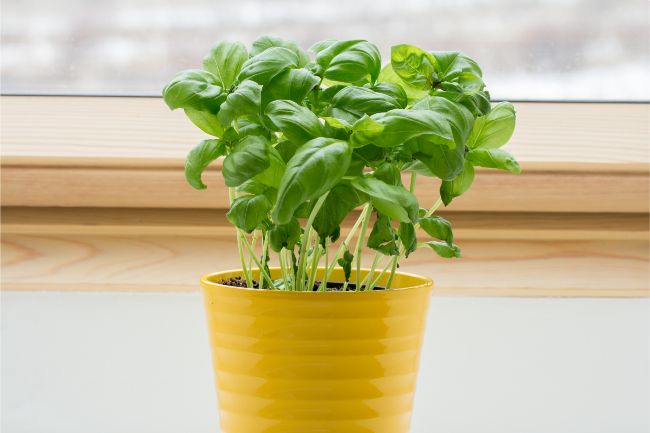
How To Propagate Basil From Cuttings
Propagation is all about getting new plants from different sources. There are three ways that you can propagate herbs: by rooting cuttings in water, planting cuttings into a growing medium, and growing basil from seeds.
The best time to propagate basil by taking cuttings is during the growing season, which is usually during spring, summer, and fall. Take cuttings from plants that aren’t flowering – flowering plants are nearing the end of their growing cycle.
Benefits of Propagating and Growing Your Own Basil
You probably don’t need much convincing that growing your own basil is a good idea, but here are just a few of the reasons why you’ll want this aromatic herb in your home:
- Basil is an amazing culinary herb that pairs well with a variety of other foods, particularly with tomatoes. Or make your own pesto to use in pasta recipes.
- Basil is a medicinal herb that can be used for numerous health conditions includinginflammation and swelling, stomach spasms, fluid retention, intestinal gas, and treating colds.
- Basil is rich in calcium, iron, magnesium, potassium, and vitamins A, K, and C.
- Basil has a pleasant aromatic scent.
- Basil flowers attract bees.
- Basil can help to repel fruit flies.
How To Propagate Basil In Water
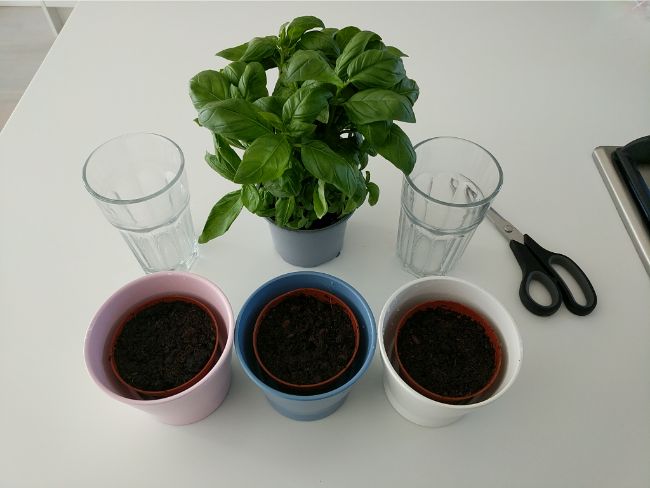
You won’t need much to propagate basil from cuttings. All you need to get started is one large, full basil plant, either a plant of your own ora plant from the nursery. Or ask your neighbors and friends for a plant from their garden. The other items you’ll need are small glass containers, a sharp knife or kitchen scissors, and fresh water. Optional are small pebbles and rooting powder. Then follow these steps:
1. Create Cuttings
Start by cleaning and sanitizing the knife or scissors. Clean in soapy water and wipe along the blade with rubbing alcohol. Then, using the sharp knife or scissors, cut below a leaf node to create cuttings that are about 4 to 5-inches long. A leaf node is where the leaf is connected to the main stem.
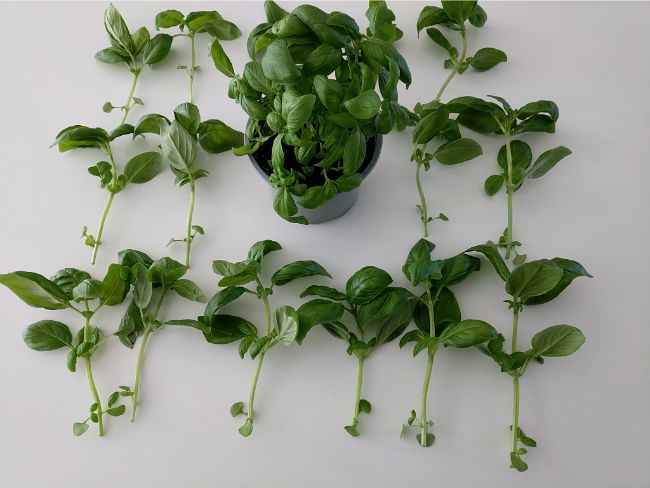
2. Prepare The Cuttings
Remove leaves from each of the cuttings so that the lower 2-inches are bare. If there are any tiny leaves just beginning, you can leave these attached if you like. I tend to remove them, particularly for water propagation. Don’t forget to put the removed basil leaves in a container and store in the fridge to use later!
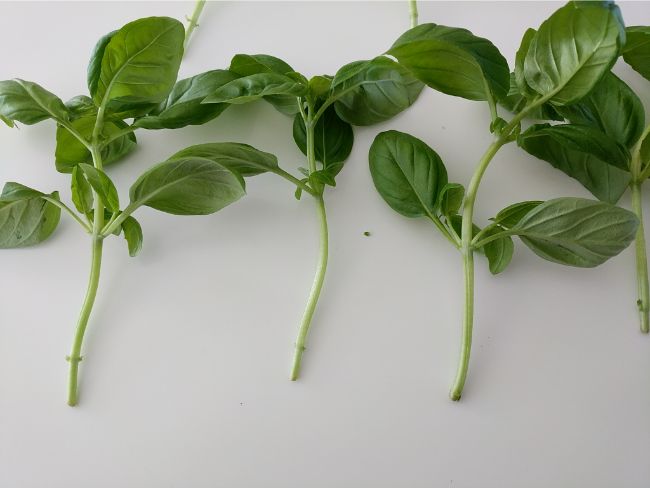
3. Place Cuttings Into Jars Or Glasses
Carefully put the cuttings into glass jars, filling with water so that the lower 2-inches of the cutting are submerged. You can fit about three to four cuttings into each jar. I usually have 5 jars, with 4 cuttings in each. Place jars on a windowsill that gets plenty of light.
Avoid direct sunlight or your little cuttings may burn in the heat. Cuttings may wilt a bit for the first day but should recover. If one or two cuttings don’t recover, you’ll still have plenty of others.
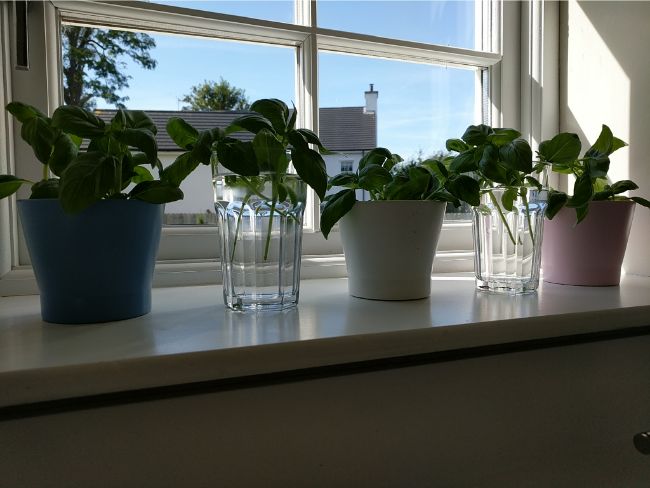
4. Optional: Pebbles
I like to put a layer of pebbles into the bottom of each jar. It adds a bit of appeal to the jars as they’re sitting on my windowsill for a few weeks.
5. Keep Water Fresh
You’ll want to keep a close eye on the water level in each jar. Add fresh water to keep the stems fully immersed in water. You’ll also need to change the water each day to keep it fresh and to prevent algae from growing. Use lukewarm tap water, rather than cold, as basil plants don’t do well in cold conditions. If you forget to change the water it will only take a day or two for the water to decay, which can cause the roots to rot and die.
6. Growing Roots
In about 5 to 7 days you should start to see tiny roots forming on the stem of the cuttings. Let the little white roots grow until they’re about 2-inches in length. The entire growing process will take about 14 to 21 days.
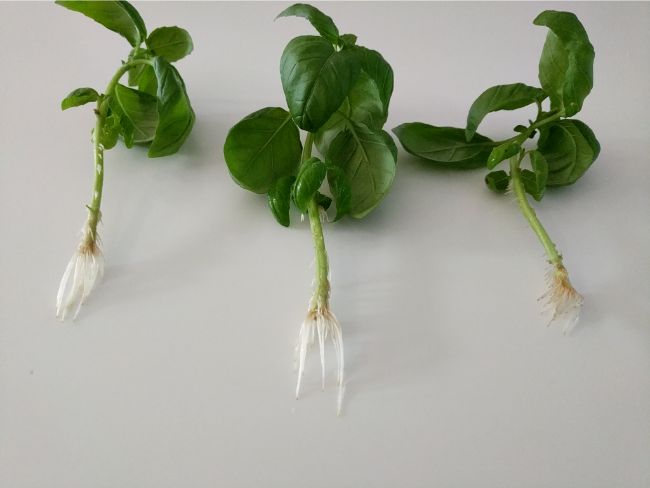
7. Planting Your Cuttings
Once roots are 2-inches, you can plant your cuttings either indoors in pots or outdoors in a sunny area that has good drainage. Pamper the planted cuttings for the first few days, keeping them protected from direct sunlight.
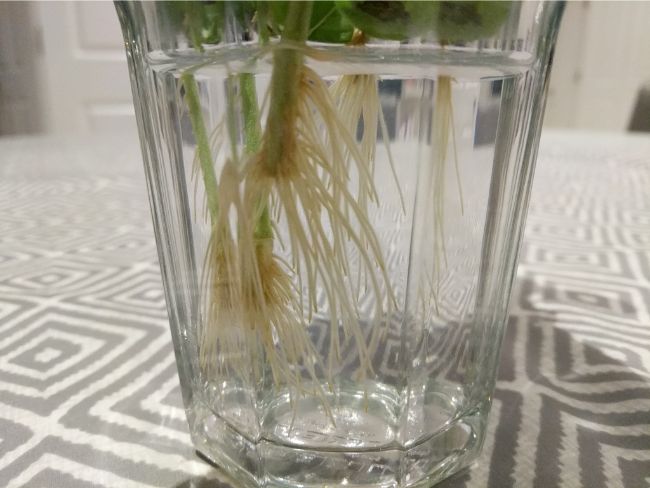
How To Propagate Basil In Soil
Another way that you can propagate basil is by planting the cuttings directly into a potting medium. With this propagation process, you’ll be bypassing the process of letting cuttings root in water. Here’s what you’ll need for this method:
- One large, healthy basil plant
- Sharp knife or kitchen scissors
- Small pots for planting
- Soilless potting mix, perlite, or vermiculite
- Optional: rooting hormone powder
1. Prepare The Soil
Fill the planting pots with the soilless potting mix, perlite, or vermiculite. Place the pots in a tray of lukewarm fresh water so that the mix can moisten from the bottom to the top. Don’t let the mixture get too wet, otherwise the roots of the cutting may rot when placed into the pot. You can buy soilless potting mix at any nursery. The mix allows ample air flow for the root structure of each basil cutting to develop and grow.
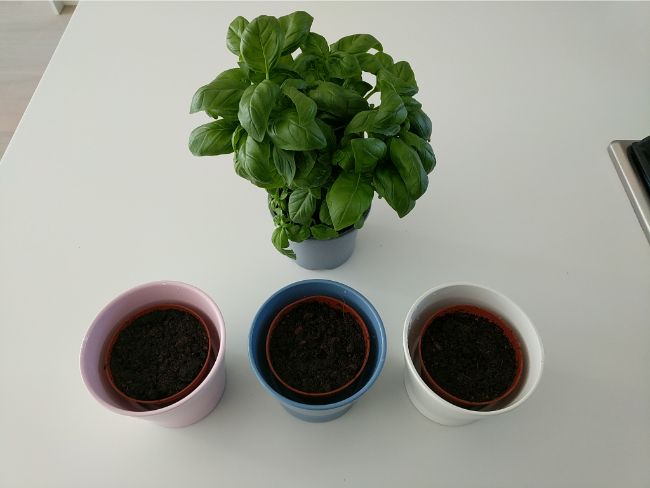
2. Take Your Cuttings
While the pots are soaking, take a 4 to 6-inch cutting from the basil plant. Choose a healthy stem and using the knife, cut the stem cleanly just below a leaf node at a 45° angle.
3. Prepare The Stems
Pinch off the lower leaves from the cutting so that the lower 2-inches are bare. It’s this section of the cutting that you’re going to be planting in the potting medium. Leave at least two to three basil leaves attached to the top section.
4. Rooting Hormone (Optional)
Rooting hormone is a powdered substance that can help cuttings take root faster. The active ingredient in rooting powder is Indole-3-butyric acid, a chemical otherwise known as chemical auxins.
Sprinkle a bit of the powder onto a piece of newspaper. Then just dip the end of the cutting into the rooting powder before planting into the pots.
5. Make Holes For The Cuttings
Using a pencil, poke a small hole into the potting mix. The hole should be deep enough to hold the lower third of the basil cutting. Gently tap soil around the cutting.
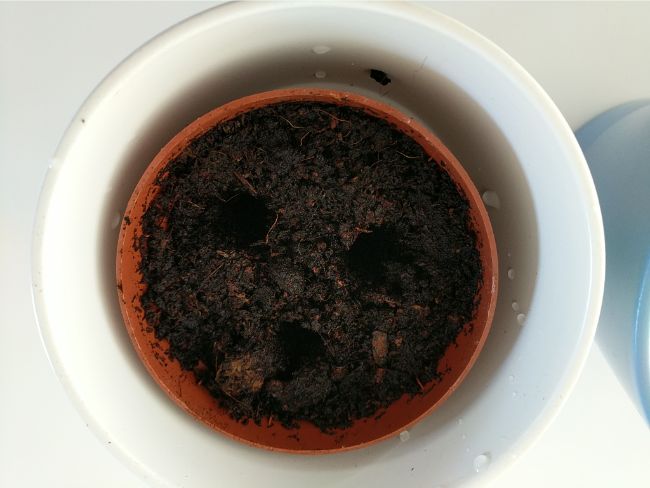
6. Position Your Basil Cuttings
Using fresh, lukewarm water, mist the pot to just moisten the top of the soil. Place the pots in a sunny location – facing east or west is ideal. A south facing window may provide too much direct sunlight which can easily burn the cuttings and cause excessive wilting.
As the cuttings root, you should also see a new growth of basil leaves. As well, the attached leaves will start to grow bigger. Don’t be tempted to start using basil now – doing so may cause the cutting to go into shock.
7. Optimize Conditions
You may be able to get the cuttings to root quicker by adding some humidity. To achieve this, you can make your own little mini-greenhouse. Place the pot into a clear plastic bag. Poke a wooden stick or pencil into the soil to drape the plastic over so it doesn’t touch the cutting. Remove the plastic after the cuttings have taken root.
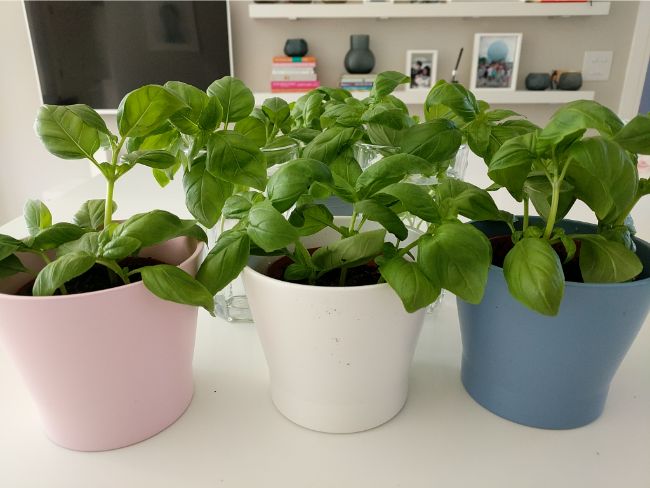
8. Caring For Your Basil Cuttings
Water once or twice each day to keep the cutting moist but not over-saturated with water. Otherwise mold may develop which can quickly kill the cutting.
It will take about two to three weeks for the cuttings to root. Let them root a bit longer in the pot, up to about four weeks to be sure the root system is well established. After this time your new basil plants are ready for planting indoors or out.
Transplanting the Cuttings Indoors
Whether you’ve propagated basil in water or used a soilless potting medium, once basil cuttings have taken root it’s time to transplant them. You can plant them indoors in pots, keeping them on sunny windowsills. Or put the pots on countertopsin a bright kitchen to use in cooking or just to add a cheery greenness to the room.
To plant indoors choose pots that have holes for drainage, so the soil doesn’t become soaked. Use organic, nutrient-rich soil. Plant your cuttings about 2-inches deep, just enough to cover the roots. Water until moist and place in a sunny location. The key to successfully growing basil indoors is to provide it with enough light. Provide at least four hours of full sun per day.
Water regularly to keep moist. I place my basil pots in a tray of pebbles to add even more drainage. Basil thrives with a bit of humidity, so use one of these methods to increase humidity for your basil plants.
Another tip to growing basil indoors is to keep the plant in temperatures of between 65˚F (18˚C) and 75˚F (23˚C). Cold temperatures will damage the leaves.
If your indoor basil plants are slow growing, you can fertilize them once every two weeks. If you’re using the basil to flavor food, you’ll need to use an organic fertilizer that’s safe to use.
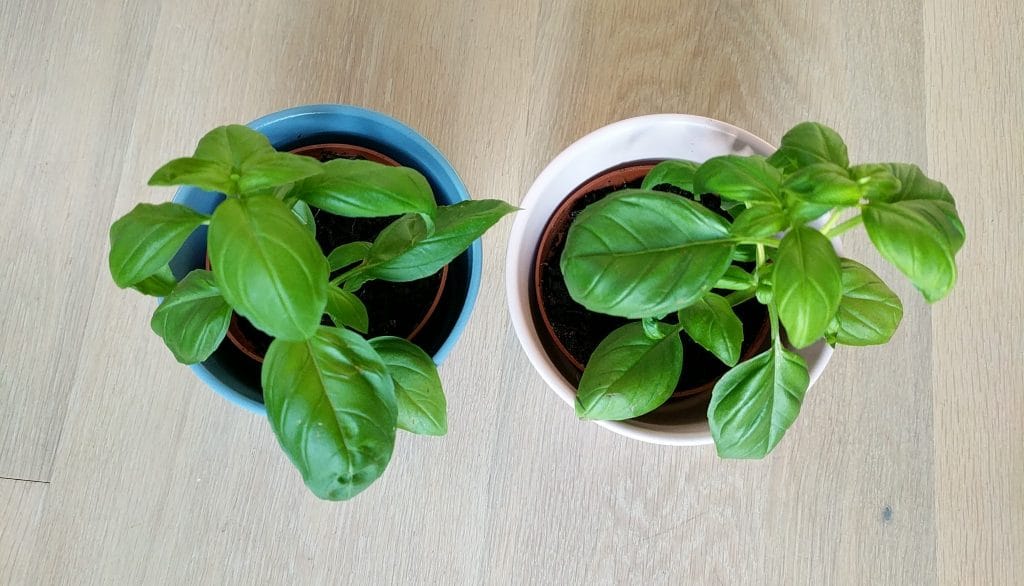
Planting Propagated Basil In Your Garden
If you’re going to transplant your propagated basil directly into the garden be sure to wait until after the last date for frost in your region. Basil is very sensitive to the cold and frost is going to quickly damage fragile new basil plants and they may not recover.
Choose an area of your garden that gets full sunlight. The soil should allow for ample drainage, so the roots don’t sit in water. I spread about 1 to 2-inches of compost into the soil to keep the roots well aerated. Water when dry, keeping the soil moist at all times.
Another note on the soil: if you’re going to be using basil in your kitchen, plant in clean soil that’s insecticide-free.
Plant the cuttings about 8 to 10-inches part, about ¼-inch deep into the soil. If the conditions are right, you can expect outdoor basil to grow to about 12 to 20-inches tall.
You can also transplant your basil cuttings into a large outdoor garden container filled with other herbs, creating a small herb garden. The pot should have several holes for drainage and be placed in full sun.
How To Propagate Basil From Seeds
A third way to propagate basil is to start it from seed. One of the most important requirements for growing basil from seeds is sunlight. Basil seeds need to have at least 6 to 8 hours of sunshine each day – so plan on starting your basil during the late spring or early summer.
Alternatively, you can use a smart herb garden to grow basil plants with little input required. I’ve used Click and Grow and Aerogarden to grow a range of herbs for the last few years with great success and entertainment.
Here’s how to propagate basil seeds:
- Moisten organic potting soil mix and lightly pack into 4 to 6-inch sized pots.
- Sprinkle the surface of the soil with a few basil seeds.
- Cover up the seeds with a ¼-inch layer of soil, pressing gently.
- Use a mister to water, taking care not to leave any standing water on top of the soil.
- Place the pots near a sunny window where they’re getting enough indirect sunlight.
- Avoid placing the pots in a drafty area or in a room where the temperature drops to below 53˚F (12˚C) at night.
- When the seedlings start to grow, turn the pots to prevent the basil shoots from growing in one direction towards the light.
- If the basil seedlings start to overcrowd the pot, thin them out – use the clippings in a salad!
- After six to eight weeks your basil plant should be ready to use, with the leaves being large enough to harvest.
When To Harvest Basil
One of the tricks to growing basil is to harvest the plant often. The more you harvest, the fuller the plant will grow. To harvest, pinch the stem directly above where two or more leaves are growing. This way more stems will begin to grow and flourish.
To keep basil leaves tasting their best, remove flowers as soon as they start to grow. Otherwise the leaves will start to taste bitter. It may be tempting to let these pretty flowers grow, but once you do the basil plant will stop growing.
In the fall, as soon as there’s a risk of frost, consider harvesting all your basil to avoid losing it all to cold temperatures. Store in the fridge if you’re going to use in a few days. Or package the leaves, chopped or whole, in tightly sealed bags in the freezer. Another storage method is to dry the basil.
FAQ
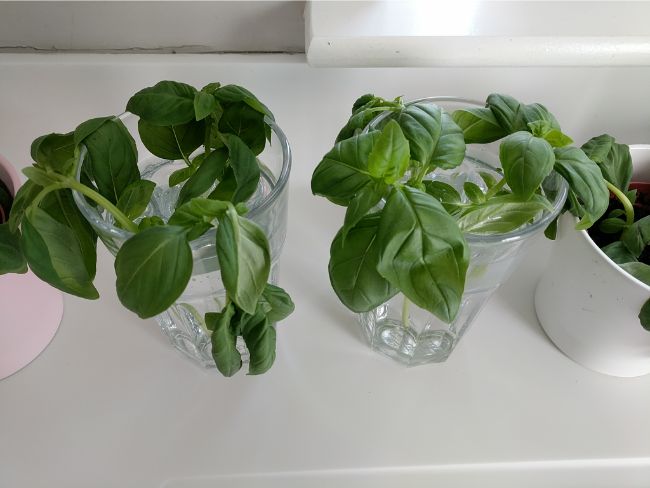
My basil cuttings seem to wilt and droop overnight, taking a while the next day to recover. I’m worried they won’t survive. What am I doing wrong?
If you’ve placed your cuttings in a jar or pot on the windowsill, check the nighttime temperature.If it’s below 40˚F (4˚C) at night, you’ll need to move the cuttings to a warmer location in your home overnight, returning them to the windowsill during the day.
I’ve propagated basil cuttings and planted indoors, but my plants are growing slowly, and the stems are spindly. How can I promote more growth?
Your basil plant may benefit from fertilizing once every two weeks. Fertilizer can also help to maintain the pH level of the soil which can encourage the plant to grow. Use organic fertilizer if you’re using the basil in cooking.
I propagated basil cuttings in water but after two weeks there is still no root growth. The top of the cutting is green and growing but the ends of the bottom stem in water have turned brown. Can I still get them to root?
It sounds like the stems have rotted in the water – it’s unlikely that you can get them to root now. I would cut off the rotted end and plant the cutting into a pot filled with potting soil to encourage root growth.
Final Words on How To Propagate Basil
Now that you know how easy it is to propagate basil and have a year-round supply, you may want to do the same with other herbs. Rooting cuttings in water works well for different herbs, particularly those that are soft-stemmed like basil. Give propagation a go with lemon balm, mint, and oregano.

